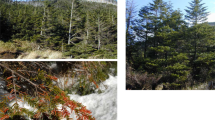Abstract
Xylem embolism in winter and spring as well as the occurrence of positive xylem pressure were monitored in several diffuse-porous and one ring-porous tree species (Fraxinus excelsior). In Acer pseudoplatanus and Betula pendula embolism reversal was associated with positive (above-atmospheric) xylem pressures that frequently occurred during a 2-month period prior to leaf expansion. In Acer high stem pressures were occasionally triggered on sunny days after a night frost. The other species investigated showed no positive xylem pressure during the monitoring period in 1995. Populus balsamifera exhibited a complete embolism reversal in 1994, but, like Fagus sylvatica, recovery was slow and incomplete in 1995. Fraxinus did not refill embolized vessels, but relied entirely on the production of new earlywood conduits in May. Populus × canadensis Moench “robusta” did not recover from embolism during the monitoring period. Under a simulated root pressure of 20 kPa however, excised branches of Populus × canadensis restored maximum hydraulic conductance within 2 days, illustrating the great influence of even small positive pressures on cnductivity recovery in spring. In the absence of positive pressure there was no substantial refilling of embolized vessels within a rehydration period of 9 days.
Similar content being viewed by others
References
Cochard H, Tyree MT (1990) Xylem dysfunction in Quercus: vessel size, tyloses, cavitation and seasonal changes in embolism. Tree Physiol 6: 393–407
Edwards WRN, Jarvis PG, Grace J, Moncrieff JB (1994) Reversing cavitation in tracheids of Pinus sylvestris L. under negative water potentials. Plant Cell Environ 17: 389–397
Ellmore GS, Ewers FW (1986) Fluid flow in the outermost xylem increment of a ring-porous tree, Ulmus americana. Am J Bot 73: 1771–1774
Ewers FW (1985) Xylem structure and water conduction in conifer trees, dicot trees, and lianas. IAWA Bull 6: 309–317
Hacke U, Sauter JJ (1995) Vulnerability of xylem to embolism in relation to leaf water potential and stomatal conductance in Fagus sylvatica f. purpurea and Populus balsamifera. J Exp Bot 46: 1177–1183
Hammel HT (1967) Freezing of xylem sap without cavitation. Plant Physiol 42: 55–66
Just J, Sauter JJ (1991) Changes in hydraulic conductivity upon freezing of the xylem of Populus × canadensis Moench “robusta”. Trees 5: 117–121
Kramer PJ, Kozlowski TT (1960) Physiology of trees. McGraw-Hill, New York
Oertli JJ (1971) The stability of water under tension in the xylem. Z Pflanzenphys 65: 195–209
O'Malley PER, Milburn JA (1983) Freeze-induced fluctuations in xylem sap pressure in Acer pseudoplatanus. Can J Bot 61: 3100–3106
Sauter JJ (1974) Maple. MacGraw-Hill yearbook of science and technology. McGraw-Hill, New York
Sauter JJ (1984) Detection of embolization of vessels by a double-staining technique. J Plant Physiol 116: 331–342
Scholander PA, Love WE, Kanwisher JW (1955) The rise of sap in tall grapevines. Plant Physiol 30: 93–104
Sperry JS (1993) Winter xylem embolism and spring recovery in Betula cordifolia, Fagus grandifolia, Abies balsamea, and Picea rubens. In: Raschi A, Borghetti M, Grace J (eds) Water transport in plants under climatic stress. Cambridge University Press, Cambridge, pp 86–98
Sperry JS, Sullivan JEM (1992) Xylem embolism in response to freeze-thaw cycles and water stress in ring-porous, diffuse-porous, and conifer species. Plant Physiol 100: 605–613
Sperry JS, Holbrook NM, Zimmermann MH, Tyree MT (1987) Spring filling of xylem vessels in wild grapevine. Plant Physiol 83: 414–417
Sperry JS, Donnelly FR, Tyree MT (1988) Seasonal occurrence of xylem embolism in sugar maple (Acer saccharum). Am J Bot 75: 1212–1218
Sperry JS, Nichols KL, Sullivan JEM, Eastlack SE (1994) Xylem embolism in ring-porous, diffuse-porous, and coniferous trees of northern Utah and interior Alaska. Ecology 75: 1736–1752
Sucoff E (1969) Freezing of conifer xylem sap and the cohesion-tension theory. Physiol Plant 22: 424–431
Tyree MT, Ewers FW (1991) The hydraulic architecture of trees and other woody plants (Transley Review Number 34). New Phytol 119: 345–360
Tyree MT, Yang S (1992) Hydraulic conductivity recovery versus water pressure in xylem of Acer saccharum. Plant Physiol 100: 669–676
Tyree MT, Davis SD, Cochard H (1994) Biophysical perspectives of xylem evolution: is there a tradeoff of hydraulic efficiency for vulnerability to dysfunction? IAWA J 15: 335–360
Wiegand KM (1906) Pressure and flow of sap in the maple. Am Nat 40: 409–453
Yang S, Tyree MT (1992) A theoretical model of hydraulic conductivity recovery from embolism with comparison to experimental data on Acer saccharum. Plant Cell Environ 15: 633–643
Zimmermann MH (1983) Xylem structure and the ascent of sap. Springer, Berlin Heidelberg New York
Author information
Authors and Affiliations
Rights and permissions
About this article
Cite this article
Hacke, U., Sauter, J.J. Xylem dysfunction during winter and recovery of hydraulic conductivity in diffuse-porous and ring-porous trees. Oecologia 105, 435–439 (1996). https://doi.org/10.1007/BF00330005
Received:
Accepted:
Issue Date:
DOI: https://doi.org/10.1007/BF00330005




